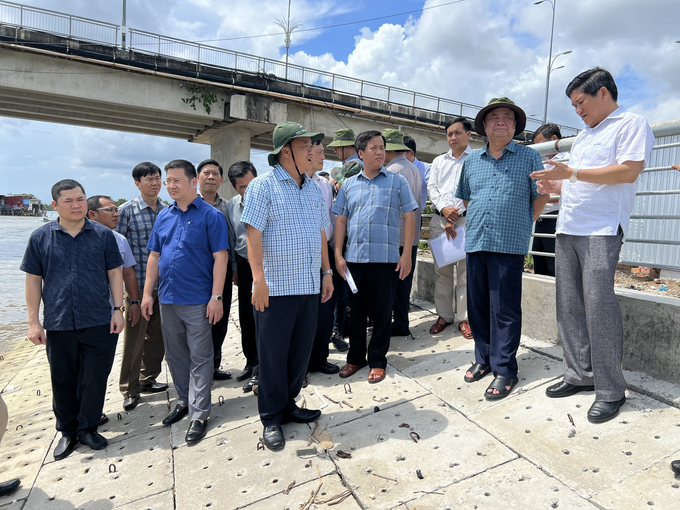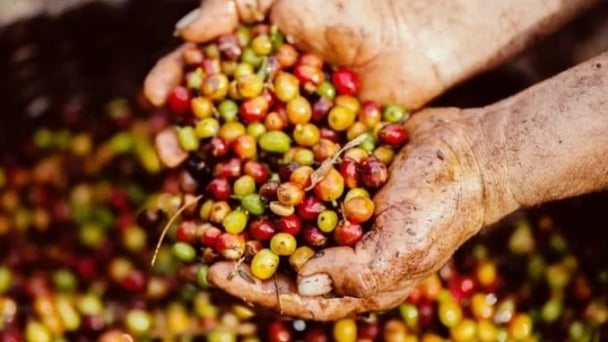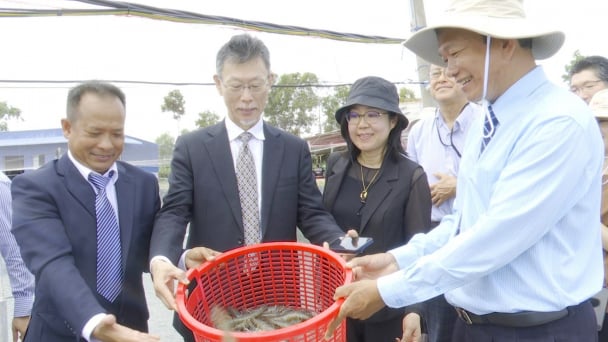June 17, 2025 | 16:54 GMT +7
June 17, 2025 | 16:54 GMT +7
Hotline: 0913.378.918
June 17, 2025 | 16:54 GMT +7
Hotline: 0913.378.918
The Minister of Agriculture and Rural Development Le Minh Hoan had an official meeting with Ca Mau Provincial People's Committee on the morning of May 11 to discuss the status of production, business, public investment, infrastructure construction and export.
Mr. Le Van Su, Vice Chairman of Ca Mau People's Committee, reported that climate change and the rising sea level have caused severe landslides along riverbanks and coasts of Ca Mau province. Out of a total of 254 kilometers, the impacted portion of the coastline is approximately 188 kilometers. Statistics show that landslides from 2011 to 2021 have damaged 5,250 hectares of coastal forests, which is equivalent to the area of one commune. Additionally, landslides on the river bank have damaged nearly 26 kilometers of roads and 237 houses. The total damage was estimated at 1,100 billion VND.

The Minister of Agriculture and Rural Development Le Minh Hoan had an official meeting with Ca Mau People's Committee to discuss the status of production, business, public investment, infrastructure construction and export. Photo: Trong Linh.
The inspection of landslide conducted in Nam Can town (Nam Can district) and Tam Giang Tay commune (Ngoc Hien district) revealed that the sea level has been rising rapidly due to the increasingly severe impacts of climatic change. This has directly affected the lives of local people, who build houses and trade goods along river routes, especially in densely populated areas. On the other hand, fast flows form in coastal or riverside areas during the high tide, specifically at intersections of tributaries, causing severe and frequent landslides.
With support from the Central Government, Ca Mau province has constructed 56.7 kilometers of coastal protection embankments with a total cost of 1,848 billion VND. These fully-funded constructions have effectively reduced waves, prevented landslides and restored nearly 1,000 hectares of protective forests through accretion. Ca Mau province and the Ministry of Agriculture and Rural Development are currently deploying nearly 31.2 kilometers of coastal protection embankments, at a cost of 1,285 billion VND to prevent potentially dangerous landslides.
Ca Mau People's Committee has directed stakeholders to monitor and update the rapid occurrence of landslides constantly. Reports have shown that landslides of varying degrees are currently affecting 100 kilometers of Ca Mau coast and 365 kilometers of its riverbank. At its current rate, landslides will continue to damage more coastal forest land if the province does not provide immediate protection solution.
If landslides advance deeper into the mainland, they will destroy infrastructures and coastal residential clusters. Subsequently, the construction of landslide prevention works will be challenging; the restoration of lost land and forests will also be costly and ineffective.
After a visit to Nam Can and Ngoc Hien districts with Ca Mau People's Committee, Minister of Agriculture and Rural Development Le Minh Hoan said, "Climate change has a significant impact on the Mekong Delta region, and Ca Mau province - which borders the East Sea and the West Sea - suffers the most".

Minister Le Minh Hoan inspecting landslides in Nam Can town, Nam Can district. Photo: Trong Linh.
Local landslides have caused tremendous damage to land and forest ecosystems as well as the people's production life.
The Central Government has invested in sea dyke infrastructure to minimize the impact and damage from landslides. The Ministry of Agriculture and Rural Development has planned multiple construction and non-structural projects to prevent landslides in the Ca Mau peninsula, including Ca Mau province.
This task requires a long-term vision to identify structural and non-structural solutions. The government can combine investment in landslide prevention dike with non-structural solutions such as afforestation, restoration of the forest ecosystems, and re-planning of people's living and production areas.

The eastern coast of Ca Mau province is severely ravaged by landslides. Photo: Trong Linh.
In addition to urgent projects in Ca Mau province, the Ministry of Agriculture and Rural Development will request authorization from the Government to develop a long-term plan for landslide prevention in this province.
The Ministry of Agriculture and Rural Development will invite foreign specialists from the Netherlands, Japan, and many others who have experience in natural disaster prevention, prevention of coastal and riverbank landslides, in order to research solutions to these issues.
Translated by Nguyen Hai Long
![Turning wind and rain into action: [5] Hue applies modern technology in disaster forecasting](https://t.ex-cdn.com/nongnghiepmoitruong.vn/608w/files/news/2025/06/17/z6704423696987_15fd32ffc26d590d204d520c9dac6786-nongnghiep-093938.jpg)
(VAN) In Hue city, modern technology has recently been applied in meteorological and hydrological forecasting and warning, helping to reduce the damage caused by natural disasters.

(VAN) A cutting-edge farming technique being implemented on an experimental ranch in Arizona's Sonoran Desert has already saved a billion gallons of water over five years, according to Civil Eats.

(VAN) Poultry and pig production and the environment can be boosted through enhanced water technology, according to new research.

(VAN) Coffee prices on June 16, 2025 are unchanged. In Vietnam, local trading prices are holding steady, ranging around VND 112,000 – VND 112,500/kg.
![Turning wind and rain into action: [4] Bringing climate bulletins to remote and isolated areas](https://t.ex-cdn.com/nongnghiepmoitruong.vn/608w/files/linhnhp/2025/06/14/1152-z6704423696987_15fd32ffc26d590d204d520c9dac6786-nongnghiep-151141.jpg)
(VAN) The Vietnam Agriculture and Nature Newspaper interviewed Mr. Vu Thai Truong, Acting Head of Climate Change and Environment at UNDP Vietnam, to gain deeper insight into how climate bulletins are delivered to farmers.

(VAN) In Tien Giang, a high-tech shrimp farm has developed a distinctive energy-saving farming model that has yielded promising results.
![Turning wind and rain into action: [3] 300.000 farmers benefit from agro-climatic bulletins](https://t.ex-cdn.com/nongnghiepmoitruong.vn/608w/files/news/2025/06/12/e5a48259d6a262fc3bb3-nongnghiep-125122.jpg)
(VAN) The agro-climatic bulletin has become a valuable tool for farmers in the Mekong Delta. After more than five years of implementation, the initiative is gradually being expanded nationwide.